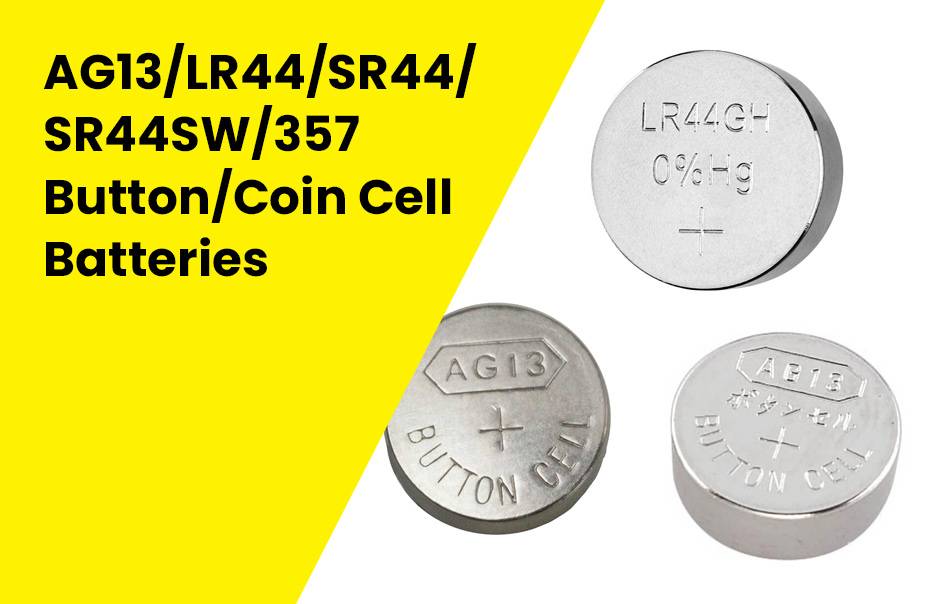AG13/LR44/SR44/SR44SW/357 button/coin cell batteries are widely used in wristwatches, small flashlights, calculators, remote control devices, thermometers, laser pointers, and other compact electronic devices.
Following the IEC standard, this battery is designated LR1154 for alkaline and SR1154 for silver-oxide variants. Alternatively, the shorter LR44 and SR44 (or SR44SW) codes are also commonly employed.
While manufacturers may employ their own nomenclature, they often include IEC and other standard codes, along with brief descriptions of the battery’s chemistry and key features.
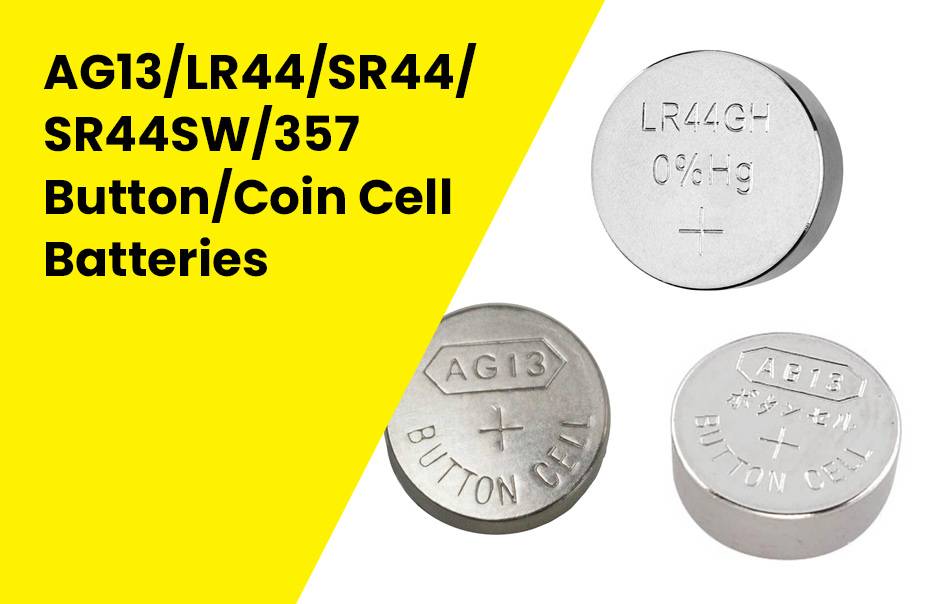
LR44/SR44 Battery Specs and Details
LR44/LR1154 (alkaline) or SR44/SR1154 (silver-oxide) batteries are button/coin cell batteries measuring 11.6 mm in diameter and 5.4 mm in height. The capacity of these batteries varies depending on the chemistry used and the cut-off voltage of the device they power.
Here are some key points to note:
- AG13 vs SG13: AG13 refers to ‘alkaline G13,’ while SG13 denotes ‘silver-oxide G13’ batteries. However, manufacturers sometimes label silver-oxide batteries with both SG13 (correct) and AG13 (less accurate) to emphasize compatibility with AG13/LR44/LR1154 batteries.
- Battery code prefixes:
- ‘L’ indicates an alkaline coin cell.
- ‘S’ denotes a silver oxide coin cell.
- ‘P’ signifies a zinc-air coin cell.
- ‘M’ or ‘N’ denotes a mercury-oxide coin cell, although these are no longer in use due to the presence of mercury.
- Electrolyte indicators:
- If the battery code after the digits contains ‘P,’ it indicates a battery with potassium hydroxide electrolyte.
- If it contains ‘S,’ it signifies a battery with sodium hydroxide electrolyte.
- Organic electrolytes:
- If the battery code after the digits doesn’t contain ‘P’ or ‘S,’ it likely contains an organic electrolyte.
- Compliance with standards:
- If the battery code after the digits contains ‘W,’ it adheres to the IEC 60086-3 watch batteries standard.
AG13/LR44/SR44/SR44SW/357 Battery Chemistries Comparison
The table below provides a comparison and examples of button/coin cell batteries measuring 11.6 x 5.4 mm:
| Chemistry | Alkaline | Silver-Oxide | Zinc Air | Mercury-Oxide |
| Nominal Voltage | 1.5V | 1.55V | 1.4-1.45V | 1.35V |
| End-Point Voltage | 1.0V | 1.2V | 1.05-1.1V | 1.1V |
| Notes | Voltage drops over time | Very constant voltage | Slightly lower voltage, large capacity; mostly used as hearing aid batteries |
Slightly lower voltage, contains mercury; not in use anymore |
| Typical Labels | LR44, 76A, AG13, LR1154, A76, L1154 | SR44W, SR44, SR44SW, 157, 357, 303, SG13, AG13, S76, A76, SR1154 | 675, Blue Tab, ZA675, PR44, 7003ZD | MR44, MR1154 |
| Typical Capacity | 110-130 mAh | 150-200 mAh | 600-700 mAh | 180-200 mAh |
| Amazon Link | LR44 AG13 Battery | SR44 357 Battery | PR44 Battery | No longer in use. |
What is the Voltage of an LR44 Battery?
The voltage of LR44 and other button/coin batteries measuring 11.5×5.4 mm depends on various factors such as battery chemistry, age, temperature, and current capacity.
Typically, the nominal voltage refers to the open-circuit voltage of a new battery at room temperature. However, as the battery discharges, its voltage gradually decreases.
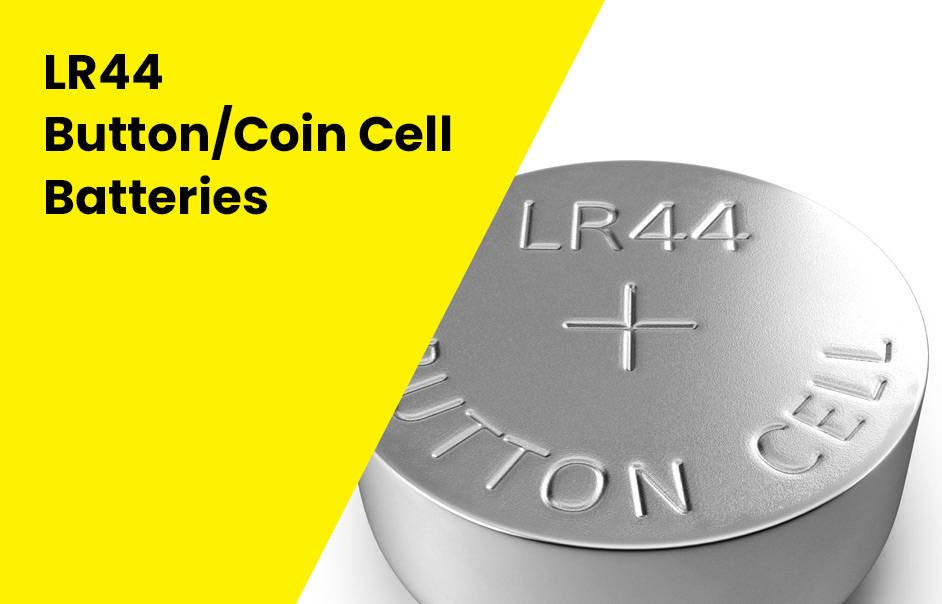
Mercury-oxide batteries, once widely used, are now obsolete due to environmental concerns associated with mercury.
Zinc-air batteries offer a slightly lower voltage (1.4 V) compared to alkaline batteries but boast a large capacity of 600-700 mAh. These batteries utilize oxygen from the air and wet electrolyte, activated by removing a tab to allow air to enter. However, once the electrolyte dries out, the battery becomes unusable, regardless of whether it has been fully depleted.
Silver-oxide batteries, with a nominal voltage of 1.55 V, provide a stable voltage output throughout their use, with a cut-off voltage around 1.2 V. They also offer a larger capacity compared to alkaline batteries, making them ideal for devices like watches and calculators that require consistent power. Although slightly more expensive, the reliability and performance of silver-oxide batteries justify the cost difference, especially when purchased in larger quantities.
Alkaline batteries, a longstanding option known for their affordability and reliability, typically offer a capacity of 110-130 mAh. However, their voltage decreases during use, which may not be suitable for devices with specific cut-off voltage requirements. Nonetheless, they remain suitable for general use in toys, flashlights, and similar applications.
LR44 Batteries Cross Reference Chart
The following cross-reference chart provides information on some of the most popular LR44, SR44, and 675 battery models, along with their key features and specifications:
| Battery Datasheet |
Chemistry
Nominal and Cutoff Voltages |
Capacity
Discharge Current |
Operating Temperature
Annual Self-Discharge Rate |
| Duracell 675 | Zinc Air
1.45V, 1.1V |
625 mAh, 620Ω @21°C down to 1.1V
– |
0°C to 50°C
4 years (unactivated) @21°C |
| Duracell 76A/LR44 | Alkaline
1.5V, 0.9/1.2V |
130 mAh, 6k8Ω @20°C down to 1.2V
– |
-10°C to +60°C
<10% @20°C |
| Duracell D303/D357 | Silver Oxide
1.55V, 0.9/1.2V |
170 mAh, 6k8Ω @20°C down to 0.9V
~0.229 mA @1.55V 6k8Ω @20°C |
0°C to +60°C
<10% @20°C |
| Energizer 357/303 | Silver Oxide
1.55V, 1.2V |
150 mAh, 6k8Ω @21°C down to 1.2V
0.204 mA @1.39V @21°C |
–
~2% @20°C |
| Energizer 675 | Zinc Air
1.4V, 1.05V |
575 mAh, IEC-STD at 15/5 mA @21°C down to 1.05V
– |
–
– |
| Energizer A76 | Alkaline
1.5V, 0.9V |
175 mAh, 6k8Ω @21°C down to 0.9V
0.191 mA @1.30V @21°C |
–
– |
| Energizer 357/303 | Silver Oxide
1.55V, 1.2V |
150 mAh, 6k8Ω, @21°C, down to 1.2V
204μA @1.39V 6k8Ω |
–
~2% @20°C |
| Eurobatt AG13 LR44 | Alkaline
1.5V, 0.9V |
130 mAh, 1.0 kΩ @20±2°C down to 0.9V
0-10 mA |
–
– |
| muRata LR44 | Alkaline
1.5V, 0.9V |
150 mAh, down to 0.9V
~0.3 mA @1.50V 4k7Ω @23°C |
-10°C to +60°C
– |
| muRata SR44 | Silver Oxide
1.55V, 1.2V |
155 mAh, down to 1.2V
~0.3 mA @1.55V 4k7Ω @23°C |
-10°C to +60°C
– |
| Rayovac 303/357 | Silver Oxide
1.55V, 1.2V |
–
~0.22 mA @1.55V 6k8Ω @20°C |
-10°C to 65°C
10 years @20°C |
| Rayovac 675 | Zinc Air
1.45V, 1.05V |
~535 mAh, IEC-STD at 15/5 mA down to 1.05V
– |
-10°C to 50°C
4 years (unactivated) @21°C |
| Renata 303 Low Drain | Silver Oxide
1.55V, 1.2V |
175 mAh, 8k25Ω @20°C down to 1.2V
~0.189 mA @1.55V 8k25Ω @20°C |
-10°C to 60°C
<5% @20°C |
| Renata 357 High Drain | Silver Oxide
1.55V, 1.2V |
190 mAh, 5k62Ω @25°C down to 1.2V
~0.272 mA @1.55V 5k62Ω @20°C |
-10°C to 60°C
<10% @20°C |
| Renata ZA675 | Zinc Air
1.45V, 1.05V |
660 mAh
– |
0°C to +45°C
<5% annually unactivated @20°C |
| Varta LR44 | Alkaline
1.5V, 0.9V |
155 mAh, 5k6Ω @20°C down to 0.9V
0.265mA |
-10°C to +65°C
– |
As observed, although nominal and cutoff voltages are generally similar across these batteries, nominal capacities vary, often influenced by the conditions under which these capacities were measured.
Batteries Similar to LR44/SR44/SR44SW
LR44/SR44/SR44SW batteries are versatile replacements, suitable not only for button 11.6×5.4 mm coin cells but also for larger batteries.
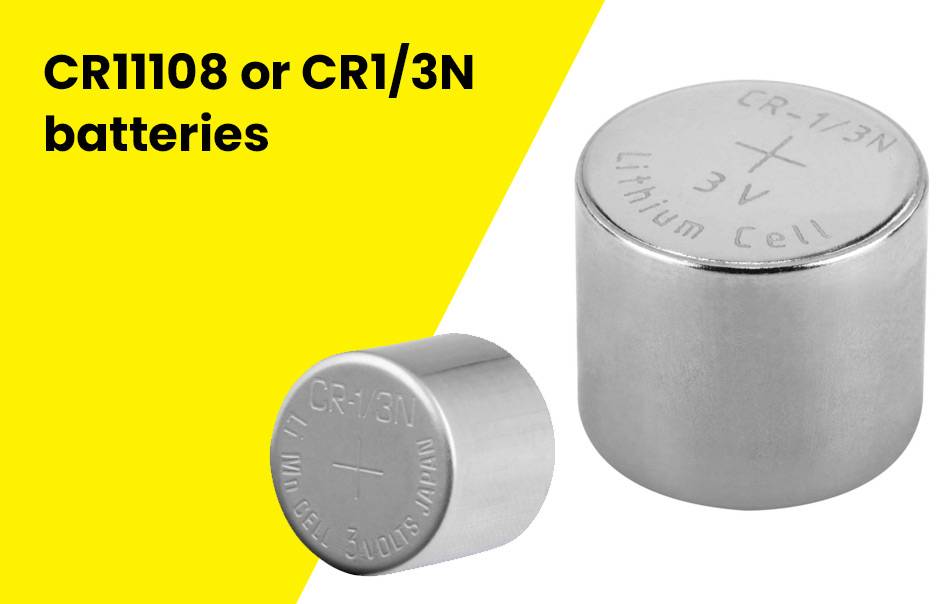
Lithium non-rechargeable CR11108 or CR1/3N batteries have a nominal voltage of 3.0 and a nominal capacity ranging from 160 to 170 mAh. With a diameter of 11.6 mm and a height of 10.8 mm, they share the same dimensions as two LR44/SR44/SR44SW batteries stacked vertically.
CR11108 or CR1/3N batteries are commonly used in various devices such as cameras, calculators, dog collars, gun sights, PDAs, and computer motherboards.
Some users opt to replace a single CR11108 battery with two LR44/SR44 batteries directly in the device, creating a battery pack with a nominal voltage of 3.1 volts (or 3.0 volts for alkaline LR44 battery) and a nominal capacity ranging from 150 to 200 mAh (110 to 150 mAh for alkaline batteries).
For more information about CR11108 batteries, you can refer to our article on CR11108, CR1/3N, CR-1/3N, DL1/3N, 2L76, 2LR44 3V Lithium Non-Rechargeable Battery Equivalents and Replacements.
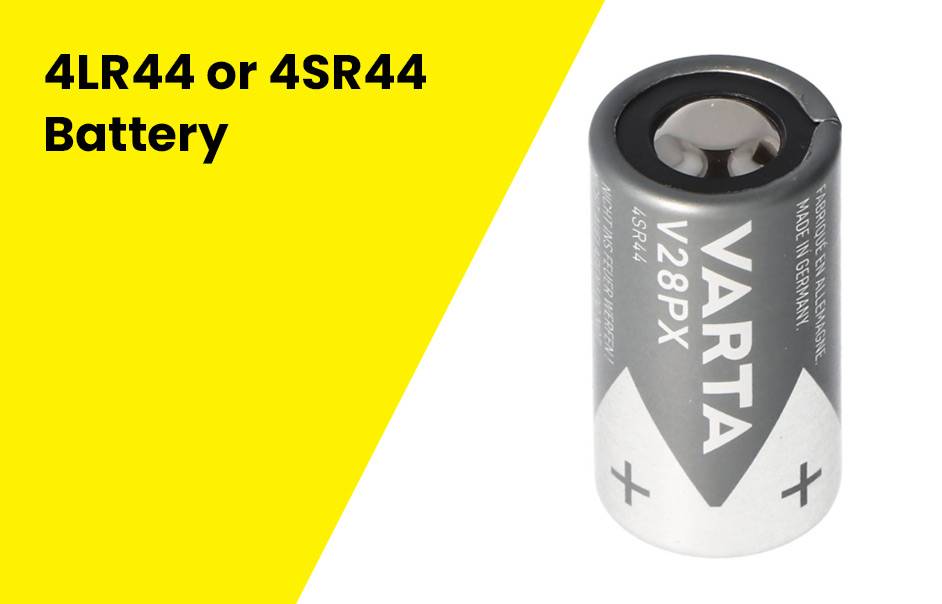
The 4LR44 or 4SR44 battery is a cylindrical battery constructed by stacking four LR44 or SR44SW batteries together. This configuration results in a battery with a nominal voltage of 6 volts for 4LR44 and 6.2 volts for 4SR44. Typically, the capacity ranges from 110 to 150 mAh for 4LR44 and from 150 to 200 mAh for 4SR44.
Physically, 4LR44/4SR44 batteries measure 25.2 mm in height and 13 mm in diameter. Some manufacturers provide devices with plastic battery holders designed to accommodate either 4LR44/4SR44 batteries or four LR44/SR44 batteries.
It’s worth noting that when stacked vertically, four LR44/SR44 batteries have a diameter of 11.6 mm and a height of 21.6 mm, necessitating a battery holder designed for a 25.2×13 mm battery compartment.
These batteries find applications in film cameras, medical instruments, flashlights, dog collars, and more.
For further information about 4SR44/4LR44 batteries, you can refer to our article on 4SR44, 4LR44, PX28A, A544, 28A, K28A Battery Equivalents and Replacements.
LR44/SR44 Battery Safety Concerns
LR44/SR44 batteries, like other small button/coin batteries, may appear enticing to curious children and pets, increasing the risk of accidental ingestion. To mitigate this risk, many manufacturers package LR44/SR44 and similar batteries in child and pet-resistant packaging, which can be challenging for even adults to open.
However, it’s important not to underestimate the determination of children and pets when it comes to accessing items that capture their interest, especially if they perceive them as forbidden.
Although modern batteries no longer contain mercury, cadmium, or other heavy metals, small button/coin batteries pose a significant danger if swallowed. When ingested, body fluids can create a circuit between the battery’s positive and negative terminals, leading to electrolysis and the release of caustic substances like sodium hydroxide. This can cause rapid and severe tissue damage, potentially resulting in serious injuries or fatalities.
If a LR44/SR44 or any similar battery is swallowed by a child, pet, or even an adult (though such instances are rare), it is crucial to contact emergency services immediately and follow their instructions. In many cases, inducing vomiting may be recommended, but it’s essential to act swiftly and precisely as directed by medical professionals.
This is a serious matter that requires urgent attention and adherence to proper safety protocols.
LR44, SR44, PR44 Batteries FAQs
Here are some frequently asked questions (FAQ) about LR44, SR44, PR44, and similar batteries:
Is an LR44 the same as a 357? Can a 357 battery replace an LR44?
No, LR44 and 357 batteries are not identical, although they are often interchangeable. The LR44 is an alkaline 11.6 x 5.4 mm button/coin cell battery, while the 357 is a high-drain silver-oxide battery of the same size. While LR44 batteries are typically cheaper, they also have a higher self-discharge rate, lower capacity, and less stable voltage compared to 357 batteries.
Is LR44 the same as CR2032?
No, the LR44 is an alkaline button cell battery measuring 11.6 x 5.4 mm with a nominal voltage of 1.5V, whereas the CR2032 is a lithium coin cell battery measuring 20 x 3.2 mm with a nominal voltage of 3.0V. Despite being non-rechargeable batteries, they differ in size, voltage, capacity, and discharge characteristics.
Can I use AA batteries instead of LR44?
No, AA batteries are cylindrical batteries measuring 14.5 x 50.5 mm, whereas LR44 batteries are coin-shaped with dimensions of 11.6 x 5.4 mm.
What is the LR44 battery equivalent to?
LR44 batteries are equivalent to various types of 11.6 x 5.4 mm batteries, including alkaline, silver-oxide, and zinc-air batteries. While they share similar dimensions and voltages, their capacity and discharge characteristics may vary depending on the specific application.
Can the LR44 battery replace the hearing aid PR44/675 battery?
Yes, the LR44 battery can fit into the PR44/675 battery compartment in hearing aid devices. However, it’s important to note that LR44 batteries have significantly lower capacity (around 150 mAh) compared to PR44/675 batteries (around 650 mAh), resulting in shorter battery life.
Summery
If you are unsure which AG13/LR44/SR44/SR44SW/357 battery to buy, go for a reliable silver-oxide SR44/357 battery with good reviews from reputable brands even if it means paying slightly more.
If you need a hearing aid battery, a good 675/P44 battery from a good company will be just fine.
FAQs
Can I use AA batteries instead of LR44?
No, AA batteries cannot be used as a replacement for LR44 batteries. This is because AA batteries are larger cylindrical batteries measuring 14.5 x 50.5 mm, whereas LR44 batteries are smaller coin batteries with physical dimensions of 11.6 x 5.4 mm. The difference in size and shape means that they are not interchangeable and cannot be used interchangeably in devices that require LR44 batteries. It is important to use the correct type and size of battery as specified by the device manufacturer for optimal performance and safety.
Is LR44 the same as CR2032?
The LR44 battery and CR2032 battery are not the same. They differ in several key aspects. The LR44 battery is an alkaline coin cell battery with a voltage of 1.5V and specific dimensions, whereas the CR2032 battery is a lithium coin cell battery with a voltage of 3.0V and different dimensions. These differences in voltage, size, and other characteristics make the LR44 and CR2032 batteries distinct from each other.
What are some batteries similar to LR44/SR44/SR44SW that can replace button coin cells like CR11108 or CR1/3N, and what are their dimensions, voltage, and capacity ranges?
LR44/SR44/SR44SW batteries serve as suitable replacements for button coin cells such as CR11108 or CR1/3N. These lithium non-rechargeable batteries share similar dimensions, with a diameter of 11.6 mm and a height of 10.8 mm. The CR11108 or CR1/3N batteries feature a 3.0 nominal voltage and a nominal capacity ranging from 160-170 mAh. Users often replace a single CR11108 battery with two LR44/SR44 batteries stacked vertically, resulting in a battery pack with a nominal voltage of 3.1 volts (or 3.0 volts for alkaline LR44 batteries) and a nominal capacity between 150-200 mAh (110-150 mAh for alkaline types). These replacement batteries find common applications in various devices like cameras, calculators, dog collars, gun sights, PDAs, and computer motherboards.
Is an LR44 the same as a 357? Will a 357 battery replace an LR44?
No, LR44 and 357 batteries are not identical, although they are often interchangeable. The LR44 is an alkaline 11.6 x 5.4 mm button/coin cell battery, while the 357 is a high-drain silver-oxide battery of the same size. While LR44 batteries are typically cheaper, they also have a higher self-discharge rate, lower capacity, and less stable voltage compared to 357 batteries. It’s important to note that these differences can impact their performance in various devices, so while they may fit in the same slot, they may not always function optimally as direct replacements for each other.

